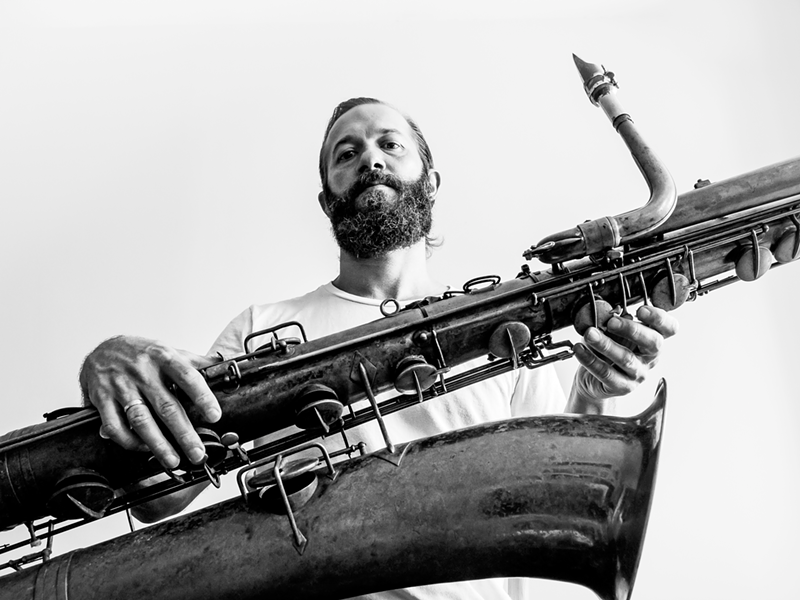If you happen to be on a plane and a nearby seat is occupied by a covered, seat-belted object that looks large enough to be a giant table lamp or even a full-bodied cadaver, there’s a good chance that it is a bass saxophone and Colin Stetson is probably on your flight.
One of the largest of the horns first built in the 19th century by Adolphe Sax, the bass saxophone is capable of deep and lower octave sounds than the more popular but smaller alto, tenor and soprano saxes. (It can also hit high notes.) But its size and weight have made it somewhat rare — people often don’t know what to make of it or where to put it.
And that has created problems for Stetson, who has made the bass saxophone his primary — although not exclusive — instrument since he began playing it in 2005. He performs solo at the Woodward Theater on Thursday to support his new album, All This I Do for Glory.
“I always buy an extra seat for it so it travels with me on the plane,” says Stetson, an Ann Arbor, Mich. native, by phone from his Montreal home. “I do still technically own a flight case that the horn can go in, but basically I’ve retired it. It has been lost in the back of planes three times now. At some point, either on the plane or on the tarmac, somebody doesn’t want to touch it and just leaves it. So I got fed up. It now comes on the plane with me and it’s not out of my sight. I don’t want a repeat of knowing if that priceless, irreplaceable piece of history is going to be brought back to me or just left in Singapore.”
While he is primarily a solo instrumentalist, Stetson isn’t really a traditional Jazz musician. He’s more a Post-Modernist whose work also incorporates New Music, Experimental, Rock and various hybrids. Live and in the studio, he’s provided horn for Arcade Fire, Bon Iver, Feist, Laurie Anderson, The National and many other progressive acts. On his own, he has now released five solo albums and served as the bandleader for Sorrow, a reimagining of Henryk Górecki’s “Symphony No. 3.”
If you’ve seen Stetson before — in Cincinnati, he has played events like MusicNow and as part Contemporary Arts Center’s Black Box Performance series — you know he’s as powerful a physical presence as a musical one when he holds and plays the bass saxophone during a solo concert. Stetson’s instrument of choice and his technique require a strong exercise regime, plus ongoing yoga and meditation, so that he can maintain the stamina and concentration necessary for his playing.
Stetson’s intense presence while performing isn’t just about the notes he plays or the volume at which he plays them — it also encompasses the variety of overall sounds the musician is able to get from his instrument. Vocal-like moans and calls, electronic hums, bee-like buzzing, rhythmic pounding or clicking — Stetson can conjure all of that and more when he picks up his horn.
When recording, takes a holistic approach to capturing the sounds he creates, placing microphones at various points around the instrument to pick up things that otherwise wouldn’t be audible using more traditional mic-ing methods.
“When I first started recording this music 10 years ago, my problem was how you get around the fact that once you put one microphone on one part of the instrument and get a snapshot of that — say you put it on the bell — you’re getting a biased sound and no longer listening to all the separate elements,” he says. “So, this (microphone placement) was really just a means to an end, to not lose anything in translation.”
For similar reasons, Stetson also doesn’t indulge in overdubbing while recording.
“Those sounds resonate in my skull through the instrument and down to my teeth and into my head,” he says. “I’m just trying to capture the sounds that exist and redistribute them in a way that is specific to the recorded medium. That’s how I make music, that’s how I hear the music — all of those sounds are aspects of the music. I don’t think in terms of separating things or adding in things later.”
That said, All This I Do for Glory is something of a departure — Stetson sees it as a progression — from his other solo work. First of all, only two of the six tracks were written for and played on bass saxophone. For the others, he uses alto sax and contrabass clarinet.
The sumptuous, sometimes darkly melancholy melodic sweep is still there on compositions with titles that connote a certain ominousness, like “Like Wolves on the Fold” and “Between Water and Wind.” But there is also at times an irresistible rhythmic catchiness to the album — especially on the under-three-minute “In the Clinches,” which might make you think of Herbie Hancock’s “Rockit.”
Stetson laughs at the notion. “I hadn’t heard Herbie Hancock once when making that record,” he says. “In no way is that a dig on Herbie Hancock.”
But Stetson does acknowledge, without exactly using the word, that this album rocks a little more than usual.
“The aesthetic is more of a rhythmically driven record in its entirety,” he says. “I suppose it still is a dark record, but in my opinion, there’s more swagger there, an ambitious bullheadedness to a lot of the tracks. I’ve tried to sew the threads of doubt through it in a very subtle way so they take a back seat to the confidence of things. This record has more of a homogenous feel, with emphasis on a rhythmic, more dance music-esque signature than has been on display in my other records. I don’t think it’s a total departure. It’s just me exploring that realm a little bit more exclusively than I have in the past.”
Did he say “dance”? People usually sit or stand in awe of Stetson when they watch him play live — some have called his concerts a religious experience akin to experiencing great Free Jazz players of the 1960s and 1970s, like Albert Ayler. And Stetson is such a serious-looking, committed player when he’s on stage, dancing almost seems inappropriate. You might fear he’ll get mad. You could feel intimidated.
But don’t be, Stetson assures.
“I’m never insulted by dancing,” he says.
COLIN STETSON performs Thursday at Woodward Theater. More info: woodwardtheater.com.






